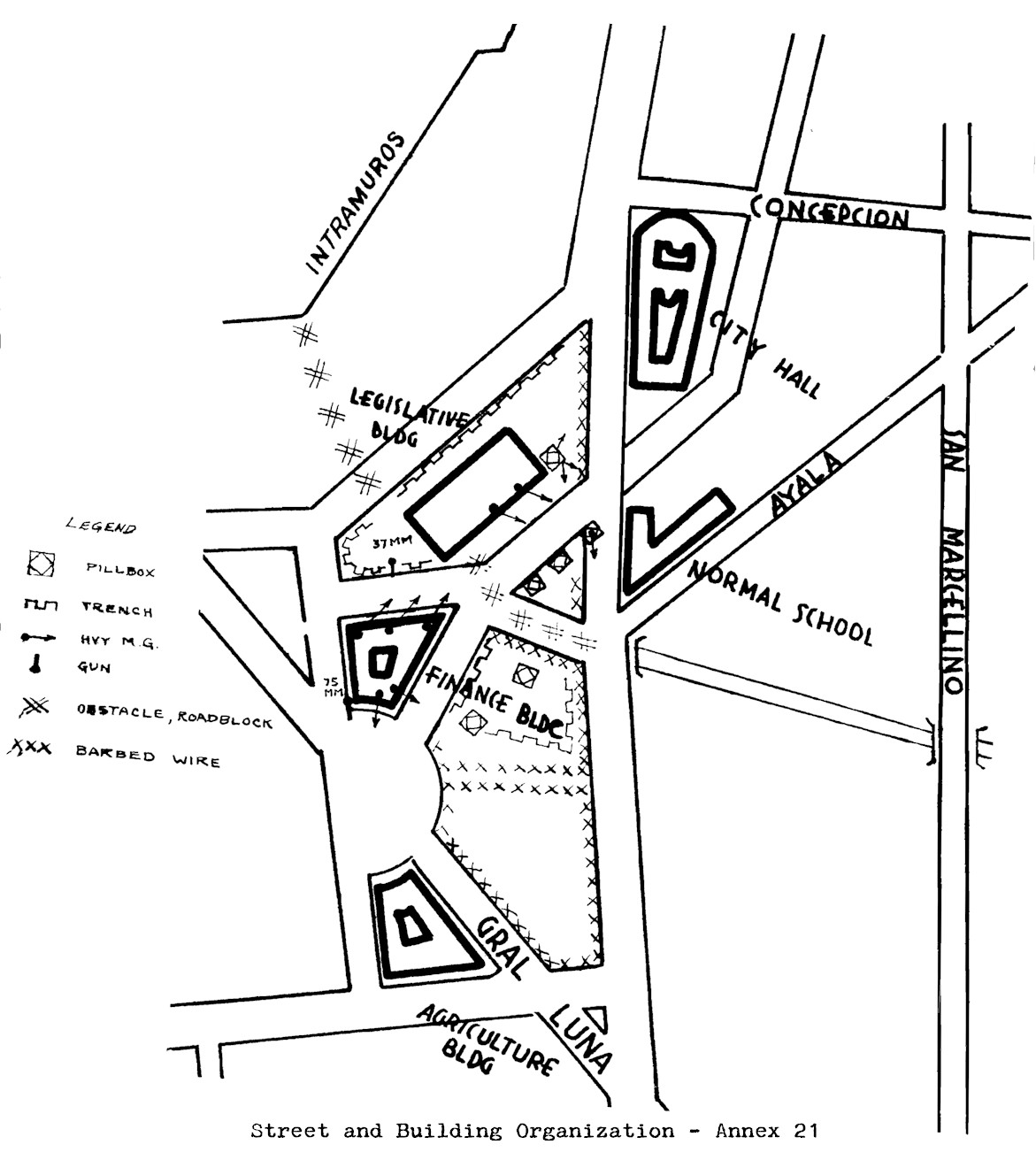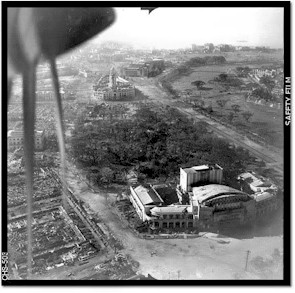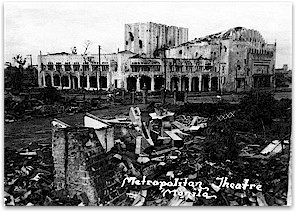|
II. SPECIFIC METHODS USED
1. Street fighting
Tactics recommended in FM 31-50 for combat
in towns were used to great advantage by U. S. Forces in the street
fighting in Manila. In the ordinary street fighting most principles used
were orthodox.
Streets were used as boundaries and units
advanced through the interior of the city block by means of alleys or
breaches made in walls. Platoon leaders assigned definite houses and
buildings for squads to search. It was found that whenever a street is
used as a boundary it should be made inclusive to one unit .
Small units worked from building to
building, endeavored to secure the top floor of a building first and then
work down through the lower floors. When a squad was used to search an
isolated building half the squad remained outside covering the grounds and
entrances while the other half entered and searched the building. On
larger buildings where platoons were used, the support squad covered the
advance of the assault squads which moved in by rushes. Once entrance was
gained, one squad would immediately attempt to gain possession of the top
floor leaving the other squad to secure the ground floor ; however, the
stairway leading to the top floor was protected in order to insure a line
of supply and evacuation until the intervening floors were secured.
Whenever a unit could advance from the top of one building to the top of
another this was done and the new building cleaned out by the top to
bottom process. In fighting from room to room explosives were freely used
to make holes in walls through which grenades or flame throwers could be
used against the enemy in adjacent rooms .
Automatic weapons were constantly used in
giving support and covering fires, and usually machine gun sections were
split to attach one light and one heavy MG to each assault platoon.
Mortars were used mostly to provide smoke screens, and to place fire on
enemy in the open.
In all aspects of street fighting it was
proved highly important not to use too many troops to search or attack a
building, but once entered, to reinforce immediately those forces which
had executed entrance. As the attack moves on, a small containing force
should be left in the building to prevent enemy infiltrators from
reoccupying positions just reduced.
Communications : In city fighting, sound
power telephones and runners were found to be the only reliable means of
communication between company and platoons. Between higher units the SCR
300 proved the best, however it was usually necessary to operate the set
from the upper level of a building.
2. Assault teams
Squads were organized into small assault
teams with bazookas and demolitions. Heavier assault weapons such as flame
throwers were kept with the platoon Hq. group available on call. In
lightly held buildings most enemy were widely scattered trying to cover
entrances, but as the more strongly fortified buildings were encountered
it was found that enemy positions commanding the inside of a building were
just as formidable as those directed to the outside. This necessitated the
increased use of special assault teams which were employed to reduce enemy
bunkers both inside and outside of buildings. In general the assault teams
employed normal technique of automatic riflemen achieving fire superiority
by firing into embrasures while flame thrower or demolitions teams
approached and destroyed the enemy position. Prior to the Luzon operation
the 37th Infantry Division had undergone an extensive training program
whereby each rifle company had a team of platoon size well versed in the
technique of assaulting fortified positions. These assault teams proved
invaluable in capturing the fortified buildings just outside Intramuros.
3. Reduction of Fortified
Buildings
a. General
The enemy defenses of Manila included
several heavily fortified buildings which stood in the open ground and
guarded the approaches to the Intramuros, and which were of the strongest
type of construction, being built to resist the earthquakes common in the
Islands. These buildings, strongly fortified inside and out, were mutually
supporting in fire, and the assault made on them by elements of the XIV
Corps incorporated most of the priciples advanced by FM 31-50, Part 1,
"Attack on a Fortified Position." While the main line of Japanese
resistance was based on these bastions, nevertheless enemy riflemen
occupied every conceivable place of vantage and were often so cleverly
concealed that the effect upon attacking troops was the same as if a wide
al'ea were being defended. It is true that this line was breached with the
capture of the Post Office Building and the assault on Intramuros then
took place, but the later capture of three buildings to the South, the
Legislative Building, Finance Building, and City Hall proved to be the
heaviest fighting in Manila.
b. Development of Technique
The modern buildings in Manila were
strongly built, earthquake proof, of heavily reinforced concrete. Many of
them were surrounded by parks and wide streets which precluded anything
except direct assault across open ground. Bwildings were laborously
converted into individual fortresses of the most formidable type with
sandbagged gun emplacements and barricades in the doors and windows
covering all approaches to the building, and emplacements within the
building itself covering the corridors and rooms. The reduction of each
building was actually a series of battles in itself. The problem of
assaulting such a fortified building, constructed to be earthquake
resistant, required a specialized solution. The first such buildings to be
encountered was the Police Station. Indirect artillery fire was placed
upon it and fire from 4.2" mortars and infantry supporting weapons. The
building was assaulted by riflemen-unsuccessfully. Tanks were then brought
in, and although two of them were put out of action by mines and enemy
fire, they succeeded in placing sufficient direct fire upon all sides of
the building to permit the final assault. Even then the Japanese did not
withdraw and the last of them were destroyed in sandbagged emplacements
dug deep in the floor of the basement. The same methods were used against
other well constructed buildings, until the large public buildings South
of the Pasig River were encountered ; namely, the City Hall, the
Metropolitan Water District Building, the General Post Office, and the
Agricultural, Finance and Legislative Buildings. Here it was necessary to
bring in 155mm howitzers for direct fire, from ranges of less than 600
yards. As building after building was captured, the techniques improved
until the final assault upon the Finance Building, which incorporated all
the techniques developed by experience up to that time. In that action
155mm howitzers, tank destroyers, and tanks fired against two sides of the
building. Because the rest of the city was in friendly hands, the direct
fire was confined to the ground and first floors in order to prevent the
danger of shells going through open windows. As the lower portions of the
outer walls disintegrated, the walls and roof settled ; but the concrete
was so strongly reinforced that the structure bent rather than collapsed.
The guns were then moved and fired at the other two walls, and the
procedure continued. Just prior to the assault, tanks and M-7's fired HE
and WP into the upper stories, thereby driving the Japs into the basement
; and immediately upon cessation of this fire, the infantry assault teams
attacked, effected an entrance through breaches in the walls, and
succeeded in eliminating the last of the enemy garrison in about four
hours.

Annex 21 - Street and Building Organization
/3
|



